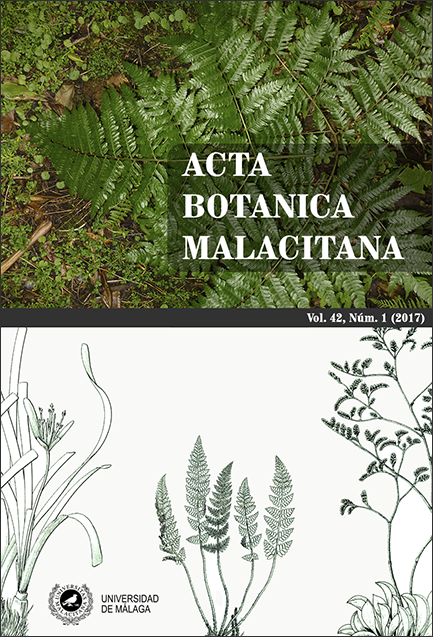Three new species of Elaphoglossum Sm. (Dryopteridaceae) from the pacific of Costa Rica.
DOI:
https://doi.org/10.24310/abm.v42i1.2382Abstract
In this paper three new species of Elaphoglossum Schott ex J. Sm., are described and illustrated, located on the pacific slope of Cordillera de Talamanca and Cerro Caraigres (Cerro Dragón), Costa Rica. The new species are: E. dragonense A. Rojas, E. flavosquamum A. Rojas and E. pacificum A. Rojas, all belong to the section Elaphoglossum subsection Pachyglossa Christ. The first species resembles E. gloeorrhizum Mickel but is separated by showing a scaly rhizome, phyllopodia with two sections, the basal one resinous as the rhizome and the second non-resinous, bigger stipe scales, and the abaxial blade is scaly. The second entity resembles E. delgadilloanum A. Rojas, but differs by having blonde to orange-yellowish rhizome scales with long lateral processes and the blade scales are mainly smaller, less dense and bicolorous with black central body and brown rays. The latter species is similar to E. cismense Rosenst., but is identified by its more slender rhizome, fronds at less distance between them, shorter phyllopodia, narrowly elliptic blade, bigger abaxial blade scales and a linear-elliptical and narrower fertile blade.Downloads
Metrics
References
Christ, K.H. (1899). Monographie des Genus Elaphoglossum. Neue Denkschr. Allg. Schweiz. Ges. Gesammten Naturwiss., 36, 1–159.
Gómez, L.D. & ARBELÁEZ A.L. (2009) Flora de Nicaragua. Tomo IV: helechos. Missouri Botanical Garden, St. Louis, Missouri, USA. 348 p.
Mickel, J.T. & Atehortúa, L. (1980). Subdivision of the genus Elaphoglossum. Amer. Fern J., 70 (2), 47–67. Mickel, J.T. &Smith, A.R. (2004). The Pteridophytes of Mexico. Mem. New York Bot. Gard. 88: 1030 p.
Moran, R.C., Garrison, J. & Rouhan, G. (2007). Spore morphology in relation to phylogeny in the fern genus Elaphoglossum (Dryopteridaceae). Int. J. Plant Sci., 168(6), 905–929.
Murillo, M.T., Murillo, J., León, A. & Triana L.A. (2008). Los Pteridofitos de Colombia. 2008. Arfo. Bogotá, D.C. 533 p.
Rojas, A.F. (2003). New taxa, new records and redefined concepts in the Elaphoglossum sect. Elaphoglossum subsec. Pachyglossa (Lomariopsidaceae) from Mexico and Central America. Rev. Biol. Trop., 51 (1), 1–32.
Rojas, A.F. (2007). Revisión taxonómica del género Elaphoglossum (Dryopteridaceae, Pteridophyta) para México y Centroamérica. Tesis de grado. Universidad Autónoma Metropolitana, Iztapalapa.
Rouhan, G., Dubuisson, J. Rakotondrainibe, F., Motley, T.J., Mickel, J.T., Labat, J. & Moran, R.C. (2004). Molecular phylogeny of the fern genus Elaphoglossum (Elaphoglossaceae) based on chloroplast non-coding DNA sequences: contributions of species from the Indian Ocean area. Mol. Phyl. & Evol., 33 (2004), 745–763.
Skog, J.E., Mickel, J.T., Moran, R.C., Volovsek, M. & Zimmer, E.A. (2004). Molecular studies of Representative Species in the fern genus Elaphoglossum (Dryopteridaceae) based on cpDNA Sequences rbcL, trnL?F, and rps4-trnS. Int. J. Plant Sci., 165 (6), 1063–1075.
Downloads
Published
How to Cite
Issue
Section
License
All information related to the licensing of published works in Acta Botanica Malacitana and copyright can be found in our Editorial Policy.







1.png)
